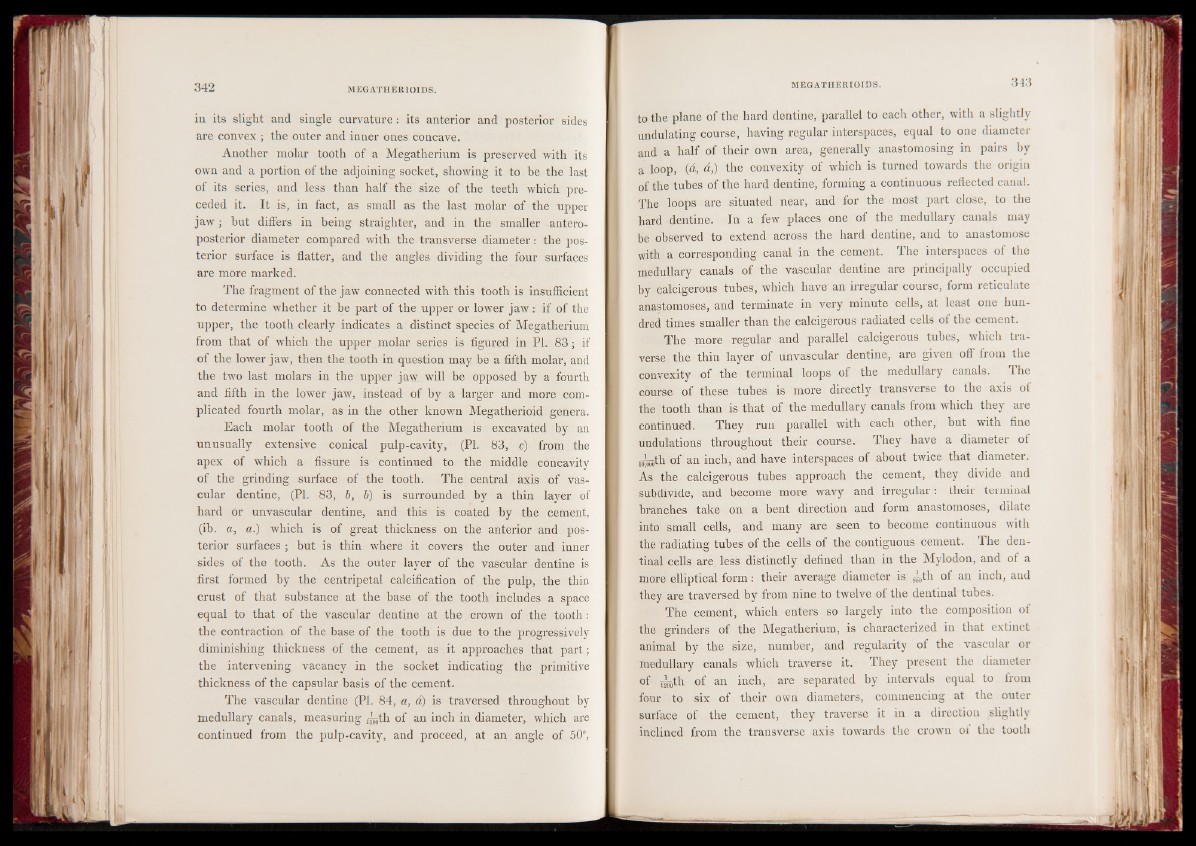
in its slight and single curvature e its anterior and posterior sides
are convex; the outer and inner ones concave.
Another molar tooth of a Megatherium is preserved with its
own and a portion of the adjoining socket, showing it to be the last
of its series, and less than half the size of the teeth which preceded
it. It is, in fact, as small as the last molar of the upper
jaw ; but differs in being straighter, and in the smaller anteroposterior
diameter compared with the transverse diameter: the posterior
surface is flatter, and the angles dividing the four surfaces
are more marked.
The fragment of the jaw connected with this tooth is insufficient
to determine whether it be part of the upper or lower jaw: if of the
tipper, the tooth clearly indicates a distinct species of Megatherium
from that of which the upper molar series is figured in PI. 83; if
of the lower jaw, then the tooth in question may be a fifth molar, and
the two last molars in the upper jaw will be opposed by a fourth
and fifth in the lower jaw, instead of by a larger and more complicated
fourth molar, as in the other known Megatherioid genera.
Each molar tooth of the Megatherium is excavated by an
unusually extensive conical pulp-cavity, (PI. 83, c) from the
apex of which a fissure is continued to the middle concavity
of the grinding surface of the tooth. The central axis of vascular
dentine, (PI. 83, b, b) is surrounded by a thin layer of
hard or unvascular dentine, and this is coated by the cement,
(ih. a, a.) which is of great thickness on the anterior and posterior
surfaces ; but is thin where it covers the outer and inner
sides of the tooth. As the outer layer of the vascular dentine is
first formed by the centripetal calcification of the pulp, the thin
crust of that substance at the base of the tooth includes a space
equal to that of the vascular dentine at the crown of the tooth:
the contraction of the base of the tooth is due to the progressively
diminishing thickness of the cement, as it approaches that part;
the intervening vacancy in the socket indicating the primitive
thickness of the capsular basis of the cement.
The vascular dentine (PI. 84, a, d) is traversed throughout by
medullary canals, measuring jJ^th of an inch in diameter, which are
continued from the pulp-cavity, and proceed, at an angle of 50°,
to the plane of the hard dentine, parallel to each other, with a slightly
undulating course, having regular interspaces, equal to one diameter
and a half of their own area, generally anastomosing in pairs by
a loop, (d, d,) the convexity of which is turned towards the origin
of the tubes of the hard dentine, forming a continuous reflected canal.
The loops are situated near, and for the most part close, to the
hard dentine. In a few places one of the medullary canals may
be observed to extend across the hard dentine, and to anastomose
with a corresponding canal in the cement. The interspaces of the
medullary canals of the vascular dentine are principally occupied
by calcigerous tubes, which have an irregular course, form reticulate
anastomoses, and terminate in very minute cells, at least one hundred
times smaller than the calcigerous radiated cells of the cement.
The more regular and parallel calcigerous tubes, which traverse
the thin layer of unvascular dentine, are given off from the
convexity of the terminal loops of the medullary canals. The
course of these tubes is more directly transverse to the axis of
the tooth than is that of the medullary canals from which they are
continued. They run parallel with each other, but with fine
undulations throughout their course. They have a diameter of
jjijjth of an inch, and have interspaces of about twice that diameter.
As the calcigerous tubes approach the cement, they divide and
subdivide, and become more wavy and irregular: their terminal
branches take on a bent direction and form anastomoses, dilate
into small cells, and many are seen to become continuous with
the radiating tubes of the cells of the contiguous cement. The dentinal
cells are less distinctly defined than in the Mylodon, and of a
more elliptical form: their average diameter is ^„th of an inch, and
they are traversed by from nine to twelve of the dentinal tubes.
The cement, which enters so largely into the composition of
the grinders of the Megatherium, is characterized in that extinct
animal by the size, number, and regularity of the vascular or
medullary canals which traverse it. They present the diameter
of ji-0th of an inch, are separated by intervals equal to from
four to six of their own diameters, commencing at the outer
surface of the cement, they traverse it in a direction slightly
inclined from the transverse axis towards the crown oi the tooth